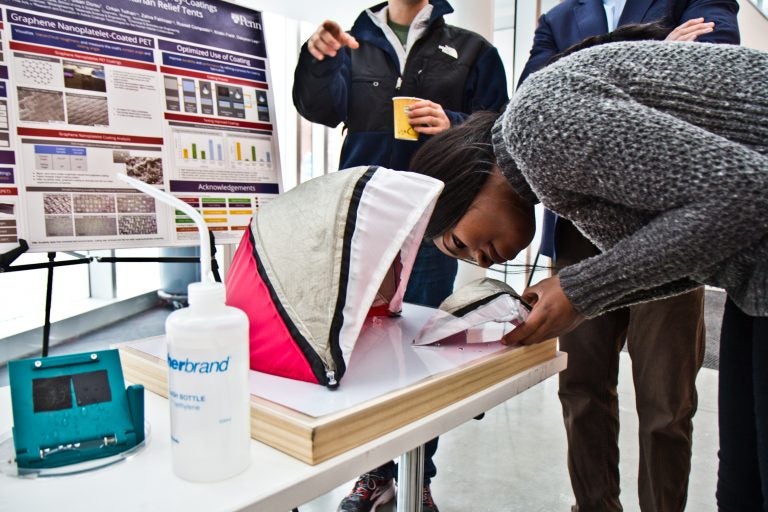Penn students aiming to build a smarter shelter for refugees
University of Pennsylvania students are working with the nonprofit ShelterBox to improve conditions for some of the millions uprooted from their homes.

University of Pennsylvania junior chemistry major Sisan Dorsu works to design a special coating for tents to temporarily house people routed from their homes. (Kimberly Paynter/WHYY)
There are 85 million people around the world who’ve been displaced by disasters — either natural or man-made. That’s according to the nonprofit ShelterBox, which provides temporary shelter for those who have been routed from their homes.
But what if ShelterBox could provide a refuge that did more than just protect against the elements?
Penn students have been pondering that very question, and, on Monday, a group of six presented an answer in the form of a new design.
The tent prototype the students created looks like a bisected armadillo shell, and it collapses — accordion-style — without any disassembly.
But the magic is in the seams, which are coated with a “superhydrophobic” substance. That coating, ideally, would channel water down the sides of the tents rather than allowing droplets to sit on the tent and evaporate.
“In this case, we wanted to replicate the lotus leaf, creating a coating that not only [prevents] water [going] through, but is repelling water,” said Penn sophomore Mauricio Alvarez.
Water is a precious commodity in refugee camps, said ShelterBox USA trustee Bill Decker. Without access to clean water, cholera and other diseases can proliferate.
“When you get your hands around that sanitation aspect of it, you can make a big difference,” he said.
If shelters could double as water collectors, displacement camps might become safer and cleaner.
“It’s kind of science meets reality,” said Decker.
The tent designs are just the final manifestation of a much larger research project underwritten by the National Science Foundation and involving faculty from 10 institutions spread across the globe. Locally, Penn, Villanova University, and Bryn Mawr College all contribute.
Dubbed REACT, the project tasks scientists with developing new coating technologies that do more than simply insulate or protect.
Doctoral candidate Emily Lin, for instance, is working on the science behind water purification. Other graduate students are exploring how new coating technologies could stop the spread of bacteria or help store and convert solar energy.
WHYY is your source for fact-based, in-depth journalism and information. As a nonprofit organization, we rely on financial support from readers like you. Please give today.





